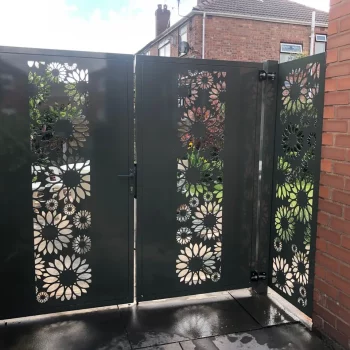Advice on erecting metal panel fencing

Metal panel fencing is a versatile favourite that can offer you home security, protection from the elements, privacy from neighbours and passers by. Metal panel fencing is a new type fencing used as a boundary. It’s relatively easy to erect and often more economical than building a wall, though, like other outdoor materials, it’s low maintenance and also long lasting.
Here we’ll take you through how to install a metal panel fence and many of our tips and instructions that may help erect metal fencing with ease.
When putting up a metal panel fence, you will require different tools to carry out the installation. With a choice of types of posts either one, you can set in concrete or another which you can bolt down to solid flooring, or free-standing posts for smaller moveable fencing. All posts come in a range of end posts, centre posts or corner posts.
1. Lay your metal fence panel flat on the floor, making sure you lay it down on something to protect it and avoid damaging the paint.
2. Placing an end fence post the side you would like to start from, and a centre fence post the other side of the metal fence panel; lining the holes up on panel and post.
3. Using the bolts provided, bolt the metal fence panel to the fence posts.
4. Once all the bolts are in place, stand up the complete metal fence panel and posts and place at the starting point of your project.
5. Repeat stage 1 but this time only adding one fence post, then with two people place this panel next to the first panel offering the metal fence panel up to the already installed fence post and bolt together, using the bolt provided.
6. If setting in concrete;
Once aligned and level and if you are using posts that needs to be set in concrete leave a 25mm-50mm gap underneath from ground to the underside of the metal panel fencing. The gap is set at 50mm on the bolts down option posts, this gap allows for any uneven section within the fence’s route. Depending on which posts you are using Add either quick drying cement or drill your holes and apply the appropriate bolts to suit the ground material you are fixing to.
Before putting up a fence, it’s essential to make some necessary checks.
Neighbours and boundaries
Talk your plans through with your neighbours if this includes their property. Check boundary lines in the property’s deeds as the fence might not have been built before. Confirm that you own the fence before you dismantle. If it belongs to a next-door-neighbour, and they won’t allow you to take it down, you can build another alongside it as long as it’s on your side of the boundary.
Maybe planning permission is required?
Planning permission isn’t generally required for fencing which is less than 2 metres (m) high. However, it will be essential if the boundary line meets a road or the footpath and you wish to construct a fence under 2m or add to a fence that’s over 1m in height. For peace of mind, you can get information about planning permission. We recommend asking your Local Authority. Go to the government’s planning portal advice website for more information about planning permission.
Before digging holes check for service cables. To do so, you can rent a cable avoidance tool (CAT) to check for any cables and pipes beneath the proposed fencing area. An excellent electrical cable installation will show electrical route marker or caution tape just above any hidden electrical cable under the ground.
If you find cables , but you’re running a fence over a solid floor (such as a patio or driveway), consider using fence post with a base plate which sits on top of the concrete, and they are bolted to the floor. These fence posts have a base plate which has been welded to the bottom of the post, which you drill the four holes into the ground and bolts down using anchor bolts.
We suggest reconsidering your fencing plans. If your proposed fencing area doesn’t cover a solid floor and cables are found.
Safety first!
- Always wear personal protective equipment when necessary.
- We suggest when undertaking any fencing project you seek the help and aid of a friend.
- Wet cement can cause burns. So If using cement, always wash your hands after use.
- If you have dry concrete on your tools – clean it off with a stiff brush.



